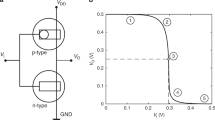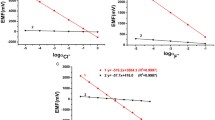Abstract
Two-dimensional real-time observation of potassium ion distributions was achieved using an ion imaging device based on charge-coupled device (CCD) and metal-oxide semiconductor technologies, and an ion selective membrane. The CCD potassium ion image sensor was equipped with an array of 32 x 32 pixels (1024 pixels). It could record five frames per second with an area of 4.16 x 4.16 mm2. Potassium ion images were produced instantly. The leaching of potassium ion from a 3.3 M KCl Ag/AgCl reference electrode was dynamically monitored in aqueous solution. The potassium ion selective membrane on the semiconductor consisted of plasticized poly(vinyl chloride) (PVC) with bis(benzo-15-crown-5). The addition of a polyhedral oligomeric silsesquioxane to the plasticized PVC membrane greatly improved adhesion of the membrane onto Si3N4 of the semiconductor surface, and the potential response was stabilized. The potential response was linear from 10–2 to 10–5 M logarithmic concentration of potassium ion. The selectivity coefficients were \(K_{{{\rm{K}}^ + }{\rm{,L}}{{\rm{i}}^ + }}^{{\rm{pot}}}{\rm{ = 1}}{{\rm{0}}^{ - 2.85}},{\rm{ }}K_{{{\rm{K}}^ + }{\rm{,N}}{{\rm{a}}^ + }}^{{\rm{pot}}}{\rm{ = 1}}{{\rm{0}}^{ - 2.30}},{\rm{ }}K_{{{\rm{K}}^ + }{\rm{,R}}{{\rm{b}}^ + }}^{{\rm{pot}}}{\rm{ = 1}}{{\rm{0}}^{ - 1.16}},\) and \(K_{{{\rm{K}}^ + }{\rm{,C}}{{\rm{s}}^ + }}^{{\rm{pot}}}{\rm{ = 1}}{{\rm{0}}^{ - 2.05}}\).
Similar content being viewed by others
References
M. Navratil, G. A. Mabbott, and E. A. Arriage, Anal. Chem., 2006, 78, 4005.
D. Hafeman, J. Parce, and H. McConnell, Science, 1988, 240, 1182.
T. Wagner, R. Molina, T. Yoshinobu, J. P. Kloock, M. Biselli, M. Canzoneri, T. Schnitzler, and M. J. Schöning, Electrochim. Acta, 2007, 53, 305.
M. J. Milgrew, M. O. Riehle, and D. R. S. Cumming, Sens. Actuators, B, 2005, 111–112, 347.
K. Sawada, S. Mimura, K. Tomita, T. Nakanishi, H. Tanabe, M. Ishida, and T. Ando, IEEE T. Electron Dev., 1999, 46, 1846.
T. Hizawa, K. Sawada, H. Takao, and M. Ishida, Sens. Actuators, B, 2006, 117, 509.
T. Hizawa, J. Matsuo, T. Ishida, H. Takao, H. Abe, K. Sawada, and M. Ishida, IEEE Transducers & Eurosensors ‘07, 2007, 1311.
M. Nomura, T. Nakao, T. Nakanishi, S. Takamatsu, and K. Tomita, Anal. Chem., 1997, 68, 977.
Y. Maruyama, S. Terao, and K. Sawada, Biosens. Bioelectron., 2009, 24, 3108.
E. Eya and G. A. Rechnitz, Anal. Chem., 1971, 43, 370.
O. Ryba and J. Petránek, J. Electroanal. Chem., 1973, 44, 425.
R. W. Cattrall, S. Tribuzio, and H. Freiser, Anal. Chem., 1974, 46, 2223.
M. Semler and H. Adametzová, J. Electroanal. Chem., 1974, 56, 155.
K. Kimura, T. Maeda, H. Tamura, and T. Shono, J. Electroanal. Chem., 1979, 95, 91.
M. Yamauchi, A. Jyo, and N. Ishibashi, Anal. Chim. Acta, 1982, 136, 399.
E. Lindner, K. Tóth, M. Horváth, E. Pungor, B. Ágai, I. Bitter, L. Tökeand, and Z. Hell, Fresenius' J. Anal. Chem., 1985, 322, 157.
M. Dror, E. A. Bergs, and R. K. Rhodes, Sens. Actuators, 1987, 11, 23.
A. S. Attyae, G. D. Christian, R. Y. X. Wen, and R. A. Bartsch, Electroanalysis, 1992, 4, 51.
D. Lee and J. D. R. Thomas, Talanta, 1994, 41, 901.
A. Bratov, N. Abramova, J. Munoz, C. Dominigguez, S. Alegret, and J. Bartroli, Anal. Chem., 1995, 67, 3589.
P. C. Hauser, D. W. L. Chiang, and G. A. Wright, Anal. Chim. Acta, 1995, 302, 241.
K.-C. Oh, E. C. Kang, Y. L. Cho, K.-S. Jeong, E.-A. Yoo, and K.-J. Paeng, Anal. Sci., 1998, 4, 1009.
S. Kim, H. Kim, K. H. Noh, S. H. Lee, S. K. Kim, and J. S. Kim, Talanta, 2003, 61, 709.
T. Katsu, Y Yokoyama, K. Ueda, K. Kohno, and T. Yamato, Anal. Sci., 2005, 21, 175.
M. Fibbioli, W. E. Morf, M. Badertscher, N. F. de Rooij, and E. Pretsch, Electroanalysis, 2000, 12, 1286.
D. N. Reinhoudt, J. F. J. Engbersen, Z. Brzózka, H. H. van den Vlekkert, G. W. N. Honig, H. A. J. Holterman, and U. H. Verkerk, Anal. Chem., 1994, 66, 3618.
N. V. Kolytcheva, O. M. Petrukhin, N. V. Filipieva, and H. Müller, Sens. Actuators, B, 1998, 48, 491.
N. Hosaka, K. Tanaka, H. Otsuka, and A. Takahara, Compos. Interface, 2004, 11, 297.
S. Y. Soong, R. E. Cohen, and M. C. Boyce, Polymer, 2007, 48, 1410.
E. Pungor, K. Toth, and H. Pall, Pure Appl. Chem., 1977, 51, 1913.
Author information
Authors and Affiliations
Corresponding author
Rights and permissions
About this article
Cite this article
Hattori, T., Masaki, Y., Atsumi, K. et al. Real-Time Two-Dimensional Imaging of Potassium Ion Distribution Using an Ion Semiconductor Sensor with Charged Coupled Device Technology. ANAL. SCI. 26, 1039–1045 (2010). https://doi.org/10.2116/analsci.26.1039
Received:
Accepted:
Published:
Issue Date:
DOI: https://doi.org/10.2116/analsci.26.1039




